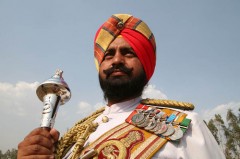03/27/2011
The hundred dollar question!
Why do Sikhs wear a turban??
A few words about this religion first.
It was founded over 500 years ago. The founder of the Sikh religion was Guru Nanak who was born in 1469. The origin of this religion is not agreed upon but it was created at a time where Hindus and Muslims kept fighting and it takes a lot from both religions. Guru Nanak preached a message of love and understanding and criticized the blind rituals of the Hindus and Muslims;
(read more below)
; he said "There is no Hindu, there is no Muslim" which has since become one of the pillars of Sikhism.
· There is only One God. He is the same God for all people of all religions.
· Sikhism condemns blind rituals such as fasting, visiting places of pilgrimage, superstitions, worship of the dead, idol worship etc.
· Sikhism preaches that people of different races, religions, or sex are all equal in the eyes of God; naturally it condemns the cast system and untouchabililty. It teaches the full equality of men and women. Women can participate in any religious function or perform any Sikh ceremony or lead the congregation in prayer.
Sikhism is open to all through the teachings of its 10 Gurus enshrined in the Sikh Holy Book. The word 'Sikh' in the Punjabi language means 'disciple', Sikhs are the disciples of God who follow the writings and teachings of the Ten Sikh Gurus.
Sikhism does not have priests, which were abolished by Guru Gobind Singh. The Guru felt that they had become corrupt and full of ego. Sikhs only have custodians of the Guru Granth Sahib (granthi), and any Sikh is free to read the Guru Granth Sahib in the Gurdwara (a Sikh temple) or in their home
Today, the Sikh religion today has a following of over 20 million people worldwide.
The most significant historical religious center for the Sikhs is Harmiandir Sahib (The Golden Temple) at Amritsar in the state of Punjab in northern India.
Why do they all bear the same family name (Singh)?
Sikhs always had to struggle against the Muslim rules and there is little doubt that Sikhs were turned into incomparable soldiers as a result of that struggle. Guru Gobind Singh (1666-1708) came up with a new code. He proclaimed absolute brotherhood and all Sikhs were to be called “Singh” (lion). So one name for everyone = equality. Like uniform in school.
Guru Gobind Singh is also the one who defined the 5 symbols of Sihkhism.
1. Kesh
Uncut hair, which is kept covered by a distinctive turban. Kesh are a traditional symbol of holiness in India, and the turban is a symbol of leadership.
Kesh has different functions, among which:
Psychological function: This is by far, one of the most important functions of hair. People cut their hair to look good for other people, and although everyone wants to look sexy and cool, a Sikh is encouraged to impress God and not bother so much about the opinions of everyone else. Keeping hair therefore encourages us to become less vain and more God orientated.
Specific function: Uncut hair is a mark of Sikh identity. The 10th Sikh Guru instructed all his Sikhs to come before him with long hair and weapons. Long hair also represents sacrifice, because there have been many Sikhs like Bhai Taru Singh, who preferred to have their scalp removed instead of their hair cut.
2. Kirpan
A ceremonial sword, symbolizing readiness to defend the defenseless, and defend one's faith against persecution.
The kirpan is normally worn on a cloth belt called a gatra.
The kirpan exemplifies the warrior character of a Sikh.
3. Kara
A steel bracelet, symbolizing strength and integrity.
Steel is symbolic of strength yet resilient under stress. In the same way, the human soul must become as strong and unbreakable as steel which has been tempered in the furnace.
4. Kangha
A wooden comb, symbolizing cleanliness and order.
The kangha is used to keep the hair clean. As a Sikh combs their hair daily, he or she should also comb their mind with the Guru's wisdom.
5. Kachhera
Cotton boxer shorts, symbolizing self-control and chastity; prohibition of adultery.
For the story (with the French):
“In March 2004, the French Parliament had passed a law banning all ostentatious religious symbols and signs in all public places such as schools, hospitals and town halls.
So far, all attempts made by Sikhs to convince the French government have failed.
The 4,000-strong Sikh community in France maintains that it needs a commitment in writing from the French government ensuring that Sikh children who have graduated from the French education system will be free to work in any government job with their turban.”
India and France already went to the European parliament regarding this matter but apparently they did not help so much. However, the prospective of business deals with India helped better and Sarkozy said he would not ban the turban!!
Sources :
http://www.religioustolerance.org/sikhism1.htm
http://www.sikhismguide.org/fiveks.shtml
http://www.sikhs.org/10gurus.htm
http://religion.indianetzone.com/1/origin_sikhism.htm
07:52 Posted in Incredible India! | Permalink | Comments (1) | Tags: india, sikh, sikhism, symbols, kesh, uncut hair, name, singh | ![]() Facebook | |
Facebook | |















Comments
Posted by: insomnie | 11/02/2011
The comments are closed.